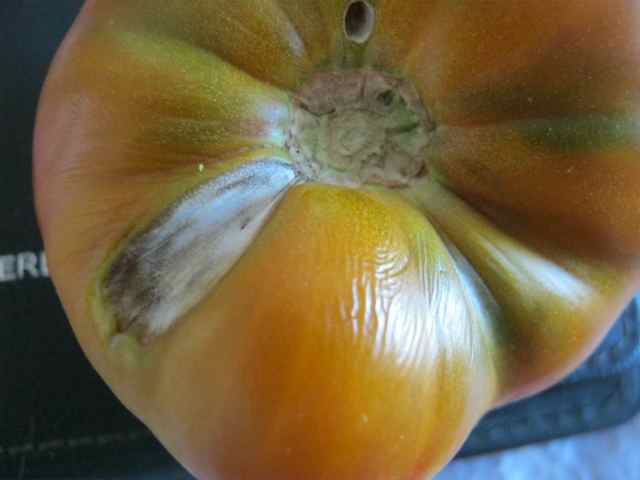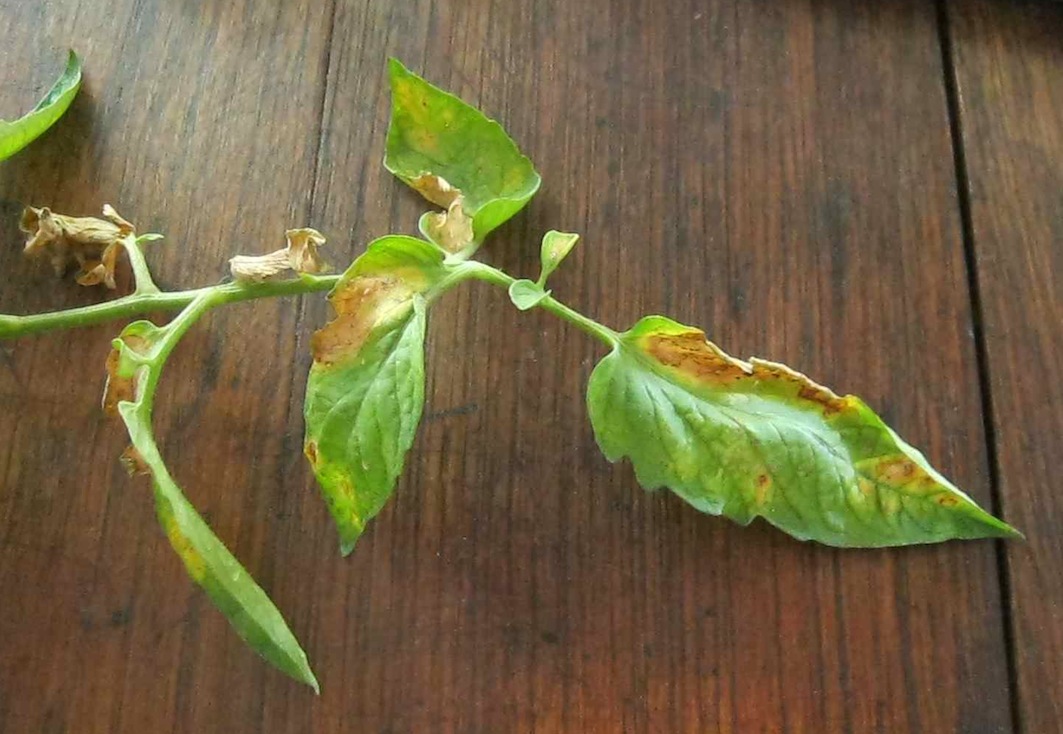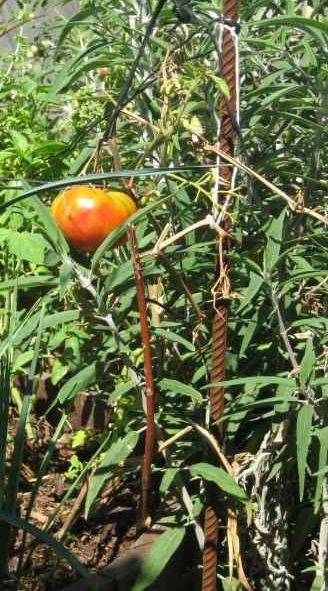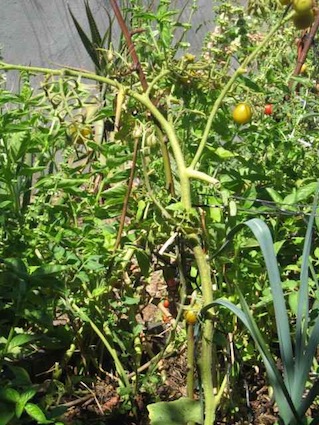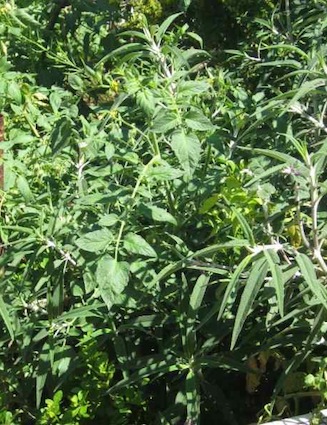Dear Reader, in this age of AI created content, please support with your goodwill someone who works harder to provide the human-made. Sign up in the righthand column or bottom of this page. You will receive my hand illustrated monthly newsletter RESTORE NATURE and access to the biodiversity garden design course as I write...and nothing else, I respect your time.
combat early tomato blight with sensible non toxic organic methods
This is my first conscious encounter with early tomato blight and powdery mildew. Around the 7th of January 2017 my husband and gardening partner alerted me to a disease/diseases affecting the leaves of our tomatoes. It is high summer, hot and dry.
I observed pale moldy spots looking like water drop stains going right through the leaf…slightly sparkly on top and dull underneath. There were also oval half pea size pale brown spots, on the small, older leaves especially. They made the leaf paper thin, pale brown underneath and a rusty color on top. Some leaves were completely curled up and dead. There were similar looking oval marks on the fruit. After a brief search online and in our handbook on plant diseases, I decided I need some distinct identifier of both kinds of disease. I began to consider the symptoms of a number of likely pathogens or problems.
identification of early tomato blight and powdery mildew
For the pale rather than the brown spots I suspect powdery mildew. It is described as causing powdery white patches on the leaves of many plants. It is common on the upper leaf surface, and is very infectious, spreading through crowded planting in days. Our tomato planting was crowded. About ten seedlings were placed 15cm apart in a wooden tub. The natural treatments were very similar to those for other fungal diseases, so I’ll include them later. My permaculture teacher would plant tomato plants a good 50 cm apart and stake them so that air could move through and down the rows.
For the brown spots there were many possible culprits. Firstly there was sun-scalding. It affects tomato fruit when temperatures are very high. That would fit, but the marks were on the shady side of the fruit, not where you would expect sunburn. Aphids would cause the leaves to be yellow, which they were, distorted, and also sticky. The leaves were definitely not sticky. Mites leave the leaf stippled or bronzed, as I had observed, and they thrive in hot dry weather, which it was, feeding on plant sap. But they leave a fine webbing below or between the leaves, something which I could not find on closer inspection. Fusarium wilt had illustrations which looked very like what I was seeing, but it spread from the edges of the leaf, not from spots in the middle of the leaf. Bacterial blights also can produce leaf lesions with pale halos, but I detected none of the typical birds eye spots (pale dot with raised black center) on the fruit.
Authors on early blight or Alternaria solani fungus showed pictures with leaf spots just like the ones I had found. It occurs throughout the US, and may have spread to South Africa. The spots were surrounded by pale halos, and had minute dark concentric rings (the distinctive bull’s eye pattern) and I had a good look with a hand lens and indeed, this was the case ! Most other identifiers checked positive. The disease can occur on all parts of the plant, and the similar spots on the ripe and unripe fruit, near the stem, which spots were leathery and sunken, fitted the picture of the disease. That the lower, older stems and leaves were affected first, that it starts from spots and spreads outwards until the leaves curl up, go yellow and die, that it occurred when the tomato was fruiting heavily, and in very hot weather, were all symptomatic of Alternaria. What didn’t coincide with the descriptions was that Alternaria favours humid conditions, It was a bone dry series of weeks. However, we had to water a lot with the watering can and fungus infection could have been brought about through splashing water on the leaves by accident, and watering at night fall. It could be a more drought resistant local strain of the fungus, so I decided that it was not certain, but highly likely to be Alternaria. The disease is also described as being capable of destroying the crop, which it didn’t seem to do, though it may have been reduced. Other descriptions concur in saying that it reduces yields. What could happen to evince terms like ‘destroy’ is that fungus on the stem, near the ground could girdle the whole plant, leading to its loss. Only one of our Black Seaman tomato bushes seemed to die off, but it still yielded a few fruit.
Late tomato blight, or Phytopthora infestans is far more devastating and thrives in cool, wet conditions. P. infestans progresses from greyish to wet black markings and these didn’t appear similar to ‘our’ disease in photographs, so temperatures and appearance ruled it out. It also requires a very similar organic prevention regime, so to help control this the same prevention can be used as that which I will describe later.
To help with identification find out from agricultural extension offices which blights are a problem in your area.
the life cycle of Alternaria solani,
or early tomato blight
Like late blight, early blight (both of which can occur any time in the season) is a fungus. That means it is phylogenetically closely related to molds not to bacteria, as some mistakenly think. However it is an imperfect fungus in that its sexually reproductive cycle has not been observed. It produces asexual spores called conidia, which can only germinate in the presence of free water, and like most fungi it has a myceleal growth stage. In the case of Alternaria this grows in and overwinters in the soil or old infected plant tissue. It can spread through physical contact between things in the garden, especially with the garden soil, and by splashing rain, irrigation, insects, tomato seeds and potato tubers, garden tools and infected hands. The tiny spore like conidia land on leaves, and in the presence of moisture, germinate rapidly, in as soon as 30 minutes, penetrating the plant within the next half day, and growing and producing lesions and more conidia within the next week or months, optimally at 26 degrees centigrade. The conidia spores spread the infection. It is more likely to invade stressed plants with nutrient deficiencies. The damp conditions which it needs to thrive are empasized in many articles, and make me doubt my identification a little.
I will deal with the different organic measures to control the fungus under the headings of the major IPM strategies: sanitize, select, treat with biological preparations and as a last restort (one I would never use but then I’m not a commercial grower) using poisonous chemicals.
using sanitation to combat early tomato blight and other fungal pathogens
The first strategy for reducing blight is basic whether you use other methods or not. This is sanitation or cleaning up and preventing infection. If you compare it to sanitation for fruit fly, you will see all sanitation is not alike. It depends very much on the life cycle and the nature of the pathogen you’re dealing with.
Once the soil is infected, it is definitely better to rotate your crops. Next year, plant tomatoes elsewhere in the garden, even if you have to plant in pots. Break the cycle of infection between related species in the Solanaceae family by rotating your crops with unrelated groups of plants for at least 3 years. Control wild populations of Solanaceae such as nightshade. Remove all volunteer Solanaceae and preferably plant Solanaceae in a different spot every year. Do not plant tomatoes and potatoes next to each other, they are both susceptible.
Keep vigilant. Check stressed plants frequently in wet weather. Monitor the lower leaves for symptoms of early blight. Remove infected leaves.
Remove and destroy all plant parts infected with early tomato blight. If only one plant is infected, pull it up and dispose of it, otherwise remove all dead or infected leaves and fruits. Do not overwinter your plants, rather clean up all plants and plant debris after the harvest. Destroy diseased plant material by burning, or putting in the trash. Do not compost it, as the pathogen survives composting.
Reduce exposure of the leaves to water because long periods of moisture on the plant encourage tomato blight. So, keep the foliage dry. Water the soil at the base of the plant, not the plant if possible. You can use drip irrigation or soaker hoses. When you plant out your seedlings, you can also bury a perforated plastic container next to the plant, into which you pour water, so that the plant is never splashed, especially by splashback from the soil. Don’t water from above. Water in the morning so your plants are dry by the end of the day when it gets cool. Plant with plenty of space between plants and stake them for air circulation. Remove suckers to increase air movement.
Create a barrier to infection between the plant and the soil. Keep the soil under plants clean and free of garden debris. But you can add a layer of organic compost or add mulch to prevent spores from the soil splashing onto the plant.
Remove the bottom branches of the tomato plant, especially if they touch the soil. Cut the branches right at the stem without harming the stem. Use plant staking or trellises to keep the plants off the soil.
Make sure humans and animals do not spread the spores around. Buy your seedling and seeds from a reliable source, not friends and neighbours. Inspect all plants you buy and only buy healthy plants. Never work in your garden when it is wet, it spreads easily through touch. Wash your hands with soap and water after working on infected plants. Disinfect your pruning shears. ( 1 part bleach to 4 parts water ) after each cut. Control insect pests which can spread the disease.
These same measures will help contain powdery mildew.
selecting varieties for crop timing and resistance to tomato blight and other tomato diseases
Choose a range of varieties maturing at different times. Earlier fruiting varieties will be more susceptible. Select wilt and nematode resistant varieties. Blight resistant tomato varieties are suggested such as ‘Stupice’, ‘Iron Lady’, ‘Jasper’ red cherry, ‘Lemon Drop’ – yellow cherry, ‘Pruden’s Purple’, ‘Red Currant’, ‘Defiant PhR’, ‘Mountain Magic’. Grafted tomatoes bred for resistance to blight are even better. Our most successful type of tomato are undoubtedly red grape tomatoes.
organic and home made treatments for tomato blight disease
To kill the mycelium of early tomato blight in the soil, solarize the soil in infected beds by turning it over, up to 6 inches. Thoroughly soak the bed by sprinkling for several hours and then cover it with a clear plastic sheet, burying the edges at least 4 inches deep to keep heat from escaping. Leave this for at least 6 weeks, but the longer the better.
Make compost tea, using 5 to 8 parts non chlorinated (stood) water to one part well aged compost. After 5 days strain it through cheesecloth and use it as a foliar spray, avoiding the fruit a month from harvest.
Dissolve one teaspoon of baking soda in one quart of warm water. Add a drop of liquid soap, or 2 tablespoons of oil. Shake thoroughly and spray the whole plant, out of direct sunlight, as it can burn the plant.
Mix 1 part skim milk to 9 parts water and spray the plant in the early summer. Milk spray twice a week is also reputed to work well for powdery mildew.
To strengthen the plant against early tomato blight, plant the tomatoes with a handful of the following mix: 3 cups compost, ½ cup powdered fat free milk, ½ cup epsom salts and 1 tablespoon of baking soda, and add some crushed eggshells, banana peels, fish bones, and 1 teaspoon of sugar.
You can spray beneficial bacterial cultures, found in some commercial products, as a preventative measure, which sounds less harmful than some sprays mentioned below. Also make your won effective micro-organism mixes from freely available and cheap materials.
hard chemical measures
Spray with copper or sulfur based fungicides every week till the disease clears. Include pyrethrins to stop the insect based infection of plants (see the dangers of pyrethrins). Also spray transplants with an anti-transpirant to keep stomata, and thus points of entry for infection, closed. The anti-transparent films can contain mercury however, not something you want on your food.
Spray at the beginning and the end of the season with 2 tablespoons each of bleach and shampoo in a gallon of water. It covers 100 square feet. They also recommend spraying a ‘broad spectrum, preventative bio-fungicide’ for the suppression of many important plant diseases. Nuking the garden for every possible pathogen will never set you up with a self righting ecosystem that keeps pathogens at a minimum. It will far more likely start off a down spiral of ecological instability. The literature also says that though its safe for food crops, copper spray is harmful to bees, and that it should therefore not be sprayed in the early morning, and caution that accumulation in the soil of copper is also toxic to humans. Peroxide based products will keep plants ‘sterile’ and free of tomato blight. What else they will sterilize, such as your beneficial equilibrium maintaining micro-organisms, is not part of this equation.
my strategy against tomato blight
Pursuing natural means of pathogen control is a trial and
error process. The above are the results of my reading research on early tomato blight. I have not
implemented most of these methods yet, except sanitation, my favored choice, as
it the basis without which other means will not be effective, and in the case of this tomato blight it requires
multiple seasons to prove itself. During my reading I noticed that many of the
aspects of garden lore I had been taught by my permaculture teacher were forms
of natural pathogen control, often based on sanitation, which would reduce tomato blight. We mulch, we remove
diseased fruit and leaves as soon as possible, we are taught to stake tomatoes
and not let them hang on the ground and remove the lower leaves close to the
ground and pinch out suckers to thin the plant,and we rotate crops religiously. It is all making more and more
sense, and comes from my teacher’s twenty years of experience. Unfortunately
the particular permaculture garden I used to work in is under spray irrigation rather than drip irrigation,
but at home I have the option of watering tomatoes in the morning from now on
so that the leaves do not remain damp long, if they are splashed at all, because
I water at the base of the plant, not from above. The presence of water on leaves is one of the causes of early tomato blight. It will take a full season to
judge the effects of changing the watering method. Initial observations seem to prioritize crop rotation of thinning the plants. As you can see below, a very thinned plant, growing in a tub that has housed tomatoes for three years in a row, is much worse off than the tomato in the diverse dense growth in the new beds I prepared earlier in the season.

------
home page for links to a myriad of useful natural gardening tips
------
vegetable gardening the low cost way using available materials
------
a link with some good close-up photos of early tomato blight
------
growing organic tomatoes is so easy
You’re a home gardener ! Share your experiences and questions !
We all know about home gardening. Tell us about your successes, challenges and ask about issues that bother you. You may have the luxury of a back garden, but there are other ways we learn. Few people age without growing something or buying vegetables during their lives ! It is absolutely guaranteed that you have learned things which can help others on their gardening journey.
We invite you to share your stories, ask questions, because if a thing has bothered you it will bother others too. Someone may have a solution ! No question is too small. There is learning for everyone involved, for you, for me (yes, I learn from every question), for us all. Exciting stuff !
We are starting on a new journey. Every week we will profile your letters ! The best stories and questions we receive.
What Other Visitors Have Said
Click below to see contributions from other visitors to this page...
Can a Carolina Reaper chili get tomato blight ? 




Dear Caroline
I have something that looks like tomato blight on my chili plant. It is a Carolina Reaper. Is this possible ?
regards
Ellie
Restore Nature Newsletter
I've been writing for four years now and I would love to hear from you
Please let me know if you have any questions, comments or stories to share on gardening, permaculture, regenerative agriculture, food forests, natural gardening, do nothing gardening, observations about pests and diseases, foraging, dealing with and using weeds constructively, composting and going offgrid.
SEARCH
Order the Kindle E-book for the SPECIAL PRICE of only
Prices valid till 30.09.2023
Recent Articles
-
Geography Research Task
Jan 31, 25 11:37 PM
To whom it may concern My name is Tanyaradzwa Madziwa and I am a matric student at Springfield Convent School. As part of our geography syllabus for this -
Eco Long Drop Pit Latrines Uganda
Nov 29, 24 02:45 AM
Good evening from the UK. My name is Murray Kirkham and I am the chairman of the International and foundation committee of my local Lindum Lincoln Rotary -
Landscape Architect
Oct 01, 24 10:42 AM
I so appreciate your informative description! Your experimentation and curiosity with the seeds, germination, and rearing of the maggot are exciting to
"How to start a profitable worm business on a shoestring budget
Order a printed copy from "Amazon" at the SPECIAL PRICE of only
or a digital version from the "Kindle" store at the SPECIAL PRICE of only
Prices valid till 30.09.2023
